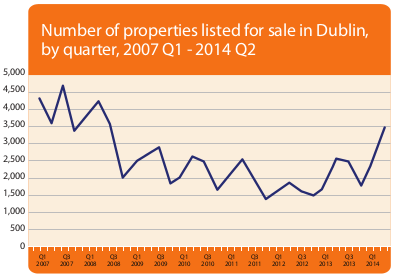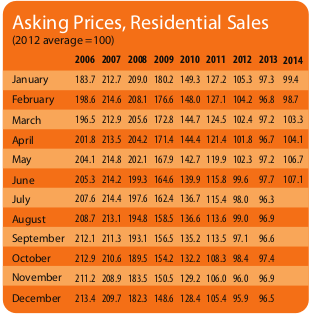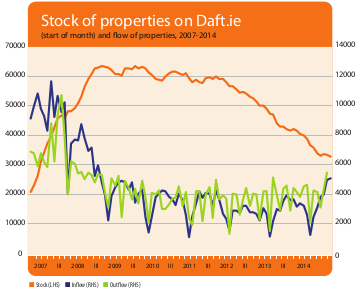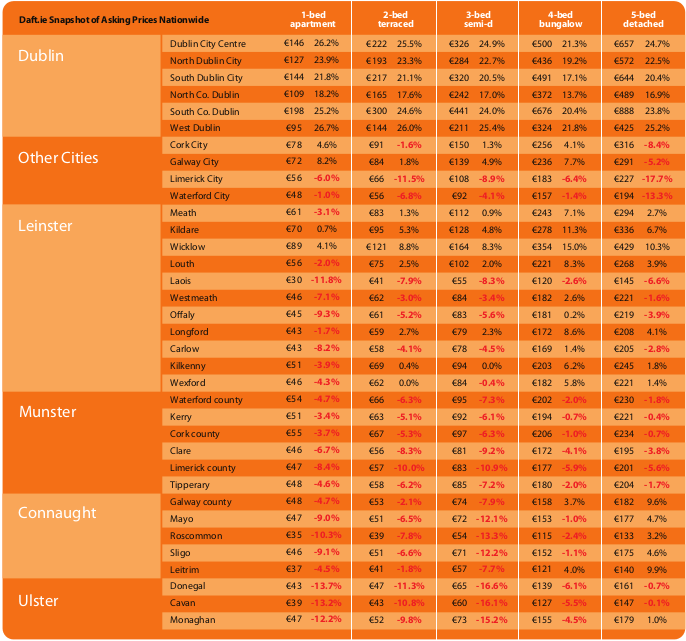Are luxury condos the solution to Ireland's urban housing shortage?
Daft Reports
- Ronan Lyons (House Price, Q1 2024)
- Ronan Lyons (Rental Price, Q4 2023)
- Ronan Lyons (House Price, Q4 2023)
- Ronan Lyons (Rental Price, Q3 2023)
- Ronan Lyons (House Price, Q3 2023)
- Ronan Lyons (Rental Price, Q2 2023)
- Ronan Lyons (House Price, Q2 2023)
- Ronan Lyons (Rental Price, Q1 2023)
- Ronan Lyons (House Price, Q1 2023)
- Ronan Lyons (Rental Price, Q4 2022)
- Ronan Lyons (House Price, Q4 2022)
- Ronan Lyons (Rental Price, Q3 2022)
- Ronan Lyons (House Price, Q3 2022)
- Ronan Lyons (Rental Price, Q2 2022)
- Ronan Lyons (House Price, Q2 2022)
- Ronan Lyons (Rental Price, Q1 2022)
- Ronan Lyons (House Price, Q1 2022)
- Ronan Lyons (Rental, Q4 2021)
- Ronan Lyons (House Price, Q4 2021)
- Ronan Lyons (Rental, Q3 2021)
- Ronan Lyons (House Price, Q3 2021)
- Ronan Lyons (Rental, Q2 2021)
- Ronan Lyons (House Price, Q2 2021)
- Ronan Lyons (Rental, Q1 2021)
- Ronan Lyons (House Price, Q1 2021)
- Ronan Lyons (Rental, Q4 2020)
- Ronan Lyons (House Price, Q4 2020)
- Ronan Lyons (Wealth, H2 2020)
- Ronan Lyons (Rental, Q3 2020)
- Ronan Lyons (House Price, Q3 2020)
- Ronan Lyons (Housing, July 2020)
- Ronan Lyons (Housing, June 2020)
- Ronan Lyons (Housing, May 2020)
- Ronan Lyons (Rental, Q1 2020)
- Ronan Lyons (House Price, Q1 2020)
- Ronan Lyons (Rental, Q4 2019)
- Ronan Lyons (House Price, Q4 2019)
- Ronan Lyons (Wealth, H2 2019)
- Ronan Lyons (Rental, Q3 2019)
- Ronan Lyons (House Price, Q3 2019)
- Pierre Yimbog (Rental, Q2 2019)
- Ronan Lyons (House Price, Q2 2019)
- Ronan Lyons (Wealth, H1 2019)
- Ronan Lyons (Rental, Q1 2019)
- Ronan Lyons (House Price, Q1 2019)
- Ronan Lyons (Rental, Q4 2018)
- Ronan Lyons (House Price, Q4 2018)
- Ronan Lyons (Wealth, H2 2018)
- Ronan Lyons (Rental, Q3 2018)
- Ronan Lyons (House Price, Q3 2018)
- Shane De Rís (Rental, Q2 2018)
- Ronan Lyons (House Price, Q2 2018)
- Ronan Lyons (Wealth, 2018)
- Ronan Lyons (Rental, Q1 2018)
- Ronan Lyons (House Price, Q1 2018)
- Ronan Lyons (Rental, Q4 2017)
- Ronan Lyons (House Price, Q4 2017)
- Ronan Lyons (Rental, Q3 2017)
- Ronan Lyons (House Price, Q3 2017)
- Katie Ascough (Rental, Q2 2017)
- Ronan Lyons (Wealth, 2017)
- Ronan Lyons (House Price, Q2 2017)
- Ronan Lyons (Rental, Q1 2017)
- Ronan Lyons (House Price, Q1 2017)
- Ronan Lyons (Rental, Q4 2016)
- Ronan Lyons (House Price, Q4 2016)
- Ronan Lyons (Rental, Q3 2016)
- Ronan Lyons (House Price, Q3 2016)
- Ronan Lyons (School Report, 2016)
- Conor Viscardi (Rental, Q2 2016)
- Ronan Lyons (Rail Report, 2016)
- Ronan Lyons (House Price, Q2 2016)
- Ronan Lyons (Rental, Q1 2016)
- Ronan Lyons (House Price, Q1 2016)
- Ronan Lyons (Rental, Q4 2015)
- Ronan Lyons (House Price, Q4 2015)
- Ronan Lyons (Rental, Q3 2015)
- Ronan Lyons (House Price, Q3 2015)
- Marcus O'Halloran (Rental, Q2 2015)
- Ronan Lyons (House Price, Q2 2015)
- Ronan Lyons (Rental, Q1 2015)
- Ronan Lyons (House Price, Q1 2015)
- Ronan Lyons (Rental, Q4 2014)
- Ronan Lyons (House Price, Q4 2014)
- Ronan Lyons (Rental, Q3 2014)
- Ronan Lyons (House Price, Q3 2014)
- Domhnall McGlacken-Byrne (Rental, Q2 2014)
- Ronan Lyons (House Price, Q2 2014)
- Ronan Lyons (Rental, Q1 2014)
- Ronan Lyons (House Price, Q1 2014)
- Ronan Lyons (Rental, Q4 2013)
- Ronan Lyons (House Price, Q4 2013)
- Ronan Lyons (Rental, Q3 2013)
- Ronan Lyons (House Price, Q3 2013)
- Ronan Lyons (Rental, Q2 2013)
- Ronan Lyons (House Price, Q2 2013)
- Ronan Lyons (Rental, Q1 2013)
- Ronan Lyons (House Price, Q1 2013)
- Ronan Lyons (Rental, Q4 2012)
- Ronan Lyons (House Price, Q4 2012)
- Lorcan Sirr (Rental, Q3 2012)
- Padraic Kenna (House Price, Q3 2012)
- John Logue (Rental, Q2 2012)
- Ronan Lyons (House Price, Q2 2012)
- Barry O'Leary (Rental, Q1 2012)
- Seamus Coffey (House Price, Q1 2012)
- Joan Burton (Rental, Q4 2011)
- Ronan Lyons (House Price, Q4 2011)
- Philip O'Sullivan (Rental, Q3 2011)
- Sheila O'Flanagan (House Price, Q3 2011)
- Rachel Breslin (Rental, Q2 2011)
- Constantin Gurdgiev (House Price, Q2 2011)
- Cormac Lucey (Rental, Q1 2011)
- Eoin Fahy (House Price, Q1 2011)
- Lorcan Roche Kelly (Rental, Q4 2010)
- Ronan Lyons (House Price, Q4 2010)
- John Fitzgerald (Rental, Q3 2010)
- Patrick Koucheravy (House Price, Q3 2010)
- Gary Redmond (Rental, Q2 2010)
- Jim Power (House Price, Q2 2010)
- Jill Kerby (Rental, Q1 2010)
- Brian Lucey (House Price, Q1 2010)
- Michael Taft (Rental, Q4 2009)
- Alan McQuaid (House Price, Q4 2009)
- Dr. Charles J. Larkin (Rental, Q3 2009)
- Emer O'Siochru (House Price, Q3 2009)
- Ronan Lyons (Rental, Q2 2009)
- Oliver Gilvarry (House Price, Q2 2009)
- Brian Devine (Rental, Q1 2009)
- Dr. Liam Delaney (House Price, Q1 2009)
- Gerard O'Neill (Rental, Q4 2008)
- Ronan Lyons (House Price, Q4 2008)
- Dr. Stephen Kinsella (Rental, Q3 2008)
- Moore McDowell (House Price, Q3 2008)
- Shane Kelly (Rental, Q2 2008)
- Fergal O'Brien (House Price, Q2 2008)
- Eoin O'Sullivan (Rental, Q1 2008)
- Dermot O'Leary (House Price, Q1 2008)
- Dan O'Brien (Rental, Q4 2007)
- Frances Ruane (House Price, Q4 2007)
- John McCartney (Rental, Q3 2007)
- Ronnie O'Toole (House Price, Q3 2007)
- Ronan Lyons (Rental, Q2 2007)
- Constantin Gurdgiev (House Price, Q2 2007)
- Fintan McNamara (Rental, Q1 2007)
- Rossa White (House Price, Q1 2007)
- Geoff Tucker (Rental, Q4 2006)
- Damien Kiberd (House Price, Q4 2006)
- Pat McArdle (House Price, Q3 2006)
- Marc Coleman (House Price, Q2 2006)
- David Duffy (House Price, Q1 2006)
- Austin Hughes (House Price, Q4 2005)
- David McWilliams (House Price, Q2 2005)

1st Jul 2014
Ronan Lyons, Daft's in-house economist, commenting on the latest Daft research on the Irish property market.
Are luxury condos the solution to Ireland's urban housing shortage?
It is now agreed by almost all commentators that what characterises the housing market in Ireland's urban areas - in particular Dublin - is a supply shortage, rather than a bubble. That is not to say a bubble, whose two characteristics are unrealistic expectations and loose credit, should not worry policymakers. The easiest way to walk into another bubble is to ignore a price spike caused by supply shortages, creating momentum in house prices that feeds into both expectations and credit. This is the lesson Ireland learned the hard way after the supply shortages of the period 1995-2001.
But the crucial difference between price rises caused by supply shortages and those caused by a credit bubble is in the solution. As the UK is discovering at the moment, it is very tricky to stop a bubble in mid-stream. As the metaphor suggests, pricking a bubble always causes it to pop.
With supply shortages, though, the answer is quite straightforward - more homes need to come on to the market. There are two ways this can happen. The first is greater churn of existing properties. With prices in Dublin up - in South County Dublin by almost 40% in two years according to the figures in this Daft Report - we are starting to see significantly more properties listed for sale.
More than 6,000 Dublin homes were put up on the market in the first half of 2014, the largest number since the same period in 2008. The picture is similar in most parts of the country, with the dramatic increase in properties coming on to the market helping to stop the downward trend in the total number of properties sitting on the market.

Figure 1. Number of properties listed for sale in Dublin, by quarter, 2007 Q1 - 2014 Q2
But greater churn will only get us so far. Building is the rest of the solution. There are simply not enough dwellings relative to families in Ireland's urban areas. To those living in many rural areas, blighted by half-built ghost estates, this may seem an odd solution. However, what first-time buyers prize now is access to amenities, in particular the amenity of job creation, which goes hand in hand with population density. The discount for distance from urban life has grown significantly in Ireland since 2006.
So far, so simple - build more family homes. And yet there is a further twist. Earlier this year, Ireland's Housing Agency commissioned research to investigate how best to deal with Ireland's demographic trends, in particular rising numbers of families living in or near cities and large towns. Their headline finding probably came as something of a surprise to most - there are enough family homes in Ireland.
The problem, of course, is that families are not the ones living in a large chunk of family homes. Instead, many of Ireland's most desirable family homes are lived in by empty nesters. What the Irish market lacks compared to its counterparts in other developed countries is both carrot and stick. The stick, for want of a better word, is property tax. In most developed countries, annual property tax bills for living in a family home are large enough that when the family home becomes an empty nest, the couple decide to downsize and save.
It may be an unpopular thing to say but - if we want housing in Ireland to be affordable - the Local Property Tax is far too low, rather than far too high. This, of course, is very easy for a commentator to say, but next to impossible for a government to bring in, unless of course it offered a revenue-neutral switch away from VAT and income tax, towards property tax.
Assuming that this will not happen in the next five years, what can be done? Well, if the stick does not exist, a bigger carrot is needed. Currently, an empty nester in Dublin looks around and sees very little that they could see themselves moving into in their early sixties. Talk of assisted living communities is certainly worthwhile - but is really a step further on, for people in their 80s, not their 60s, which is when the market needs movement.
So what needs to be done? While the economics revolves around reducing the cost of building, the psychology is simpler. What kind of higher-density home would someone in their 60s want to move into? I would suggest that there are two aspects to this. The first is location: someone who has lived in Rathfarnham or Clontarf for more than twenty years, for example, has built their network of family and friends in that area. Dublin needs to "densify" its suburbs, building apartment blocks close to family, friends and amenities.
But not just any old apartment blocks - if the first criterion is location, the second is quality. We can't expect empty-nesters to give up their family home and move into the sort of apartment most people think of when they hear the word: built in the 1990s, pokey and paper-thin walls. I am realistic enough to believe that no Irish politician will bring in the higher property tax that works in other countries. So to prevent supply shortages from turning into another property bubbles, we need the carrot of top-end apartments - call them condos, duplexes, luxury, deluxe or what you will - that empty-nesters will be proud to call home.
HIGHLIGHTS:
Asking Prices, Residential Sales

Stock and Flow of Sale Properties
SNAPSHOT:

Snapshot of Asking Prices Nationwide
